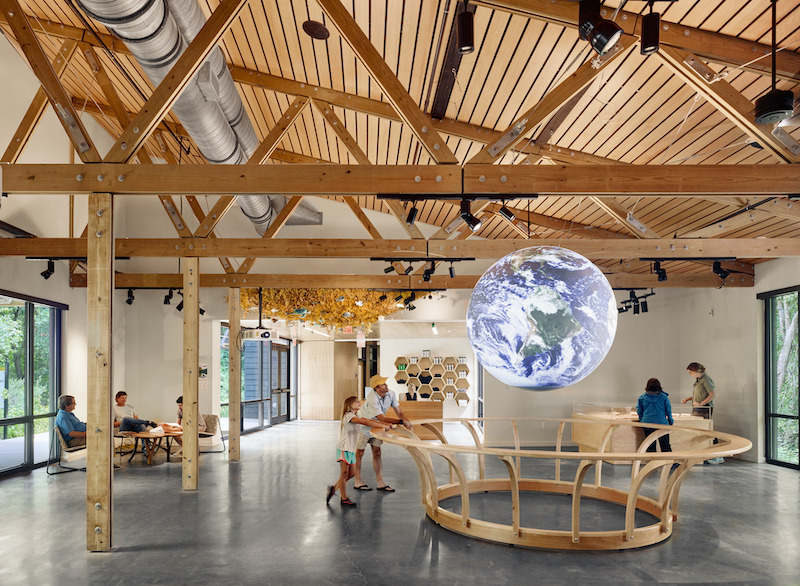The American Institute of Architects (AIA) Committee on the Environment (COTE) is announcing this year’s recipients for its highest honor, the COTE Top Ten Awards. Complete details for each project are available on AIA’s website.
COTE bestows the award annually on 10 design projects that have expertly integrated design excellence with cutting-edge performance in ten key areas. The COTE Top Ten winning projects illustrate the solutions architects provide for the health and welfare of our communities and planet.
In order to be eligible, project submissions are required to demonstrate alignment with COTE’s rigorous criteria, 10 measures that include social, economic, and ecological values. The five-member jury evaluates each project submission based on the effectiveness of their holistic design solution and metrics associated with the 10 measures. This year’s COTE Top Ten Awards recipients are as follows:
- Austin Central Library, Austin, Texas | Lake|Flato Architects + Shepley Bulfinch Joint Venture
- U.S. Land Port of Entry, Columbus, New Mexico | Richter Architects
- Etsy Headquarters, New York | Gensler
- Ford Foundation Center for Social Justice, New York | Gensler
- John W. Olver Design Building, Amherst, Massachusetts | Leers Weinzapfel Associates
- Keller Center - Harris School of Public Policy, Chicago | Farr Associates (Design Lead & Architect of Record) and Woodhouse Tinucci Architects (Collaborating Architect, Interior Designer)
- Marine Education Center at the Gulf Coast Research Laboratory, Ocean Springs, Mississippi | Lake|Flato Architects in association with Unabridged Architecture
- The Six, Los Angeles | Brooks + Scarpa
- UPCycle, Austin, Texas | Gensler
Jurors also designated one project as a Top Ten Plus recipient for its exceptional post-occupancy performance data. This year's recipient is:
- Environmental Nature Center and Preschool, Newport Beach, California | LPA, Inc.
Visit AIA’s website for more information on the COTE Top Ten Awards program.
In conjunction with COTE, the Association of Collegiate Schools of Architecture (ACSA) has selected the COTE Top Ten for Students, honoring exceptional student design projects showcasing innovation in sustainability. View the winning designs on ACSA’s website.
“The students being honored should be commended for their work and design intelligence. They provide great hope that future architects will have the skills and solutions to make our world better by integrating beautiful design with equitable climate action for human and ecological health,” said Julie Hiromoto, AIA, chair of COTE. “The COVID-19 pandemic has highlighted how necessary and valuable innovative design solutions are for healthy built environments.”
Since committing to environmental stewardship last year, architects have made notable progress in the climate action fight. Visit AIA’s website to learn more about all the climate action progress being made, including our first Climate Action Plan.
Related Stories
| May 22, 2014
NYC's High Line connects string of high-profile condo projects
The High Line, New York City's elevated park created from a conversion of rail lines, is the organizing principle for a series of luxury condo buildings designed by big names in architecture.
| May 22, 2014
Just two years after opening, $60 million high school stadium will close for repairs
The 18,000-seat Eagle Stadium in Allen, Texas, opened in 2012 to much fanfare. But cracks recently began to appear throughout the structure, causing to the school district to close the facility.
| May 22, 2014
Senate kills bipartisan energy efficiency bill over Keystone pipeline amendment
The legislation focused on energy efficiency standards such as water heaters with smart meters and cheaper heating and cooling systems for office buildings.
| May 22, 2014
IKEA to convert original store into company museum
Due to open next year, the museum is expected to attract 200,000 people annually to rural Älmhult, Sweden, home of the first ever IKEA store.
| May 21, 2014
Evidence-based design practices for the palliative care environment
Palliative care strives to make patients comfortable as they are receiving treatment for a severe illness. As hospitals seek to avoid Affordable Care Act penalties for poor patient satisfaction, many expect this field to grow quickly.
| May 21, 2014
Gehry unveils plan for renovation, expansion of Philadelphia Museum of Art [slideshow]
Gehry's final design reorganizes and expands the building, adding more than 169,000 sf of space, much of it below the iconic structure.
| May 21, 2014
Check out Pandora's posh NYC offices [slideshow]
The new East Coast office for the Internet radio provider is housed on two interconnected floors of the classic 125 Park Avenue building, and features multiple spaces for music performances, large gatherings, and “all hands” meetings.
| May 21, 2014
Architecture Billings Index in the negative for second consecutive month
The March ABI score was 49.6, up slightly from a mark of 48.8 in March, but still below the growth threshold of 50.
| May 20, 2014
Kinetic Architecture: New book explores innovations in active façades
The book, co-authored by Arup's Russell Fortmeyer, illustrates the various ways architects, consultants, and engineers approach energy and comfort by manipulating air, water, and light through the layers of passive and active building envelope systems.
| May 20, 2014
Gensler envisions 'law firm of the future' with pop-up office project
Called "The Legal Office of the Future," the pop-up demonstration project made its debut this week at the annual conference for the Association of Legal Administrators in Toronto.

















